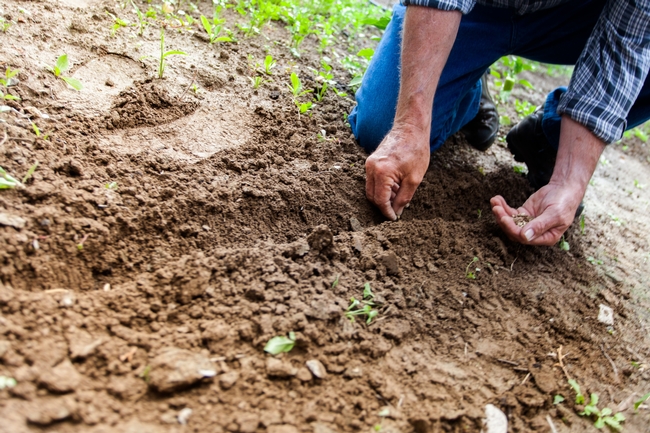Soil quality is critical to healthy plants and is a vital part of our living ecosystem. Soil is alive with organisms; their populations change depending on what is added, how the soil is used, and environmental conditions. Soil health, much like our own, is best improved gradually over time so focusing on regular or constant improvement helps achieve and sustain soil health. Do you have a soil problem in your garden? Below are some of the most common soil problems and how to fix them.
First, it is important to know what type of soil you have. According to the UC Master Gardener Handbook, good soil is 25% Air, 25% Water, 5% Organic Matter and 45% Mineral Matter. Soils are classified by the size of soil particles. Soil Particles range from large or “Sandy” to medium or “Loamy” to very fine or “Clay” with Loam being considered the best for growing plants. Get to know your soil and soil type with tips from the UC Master Gardener Program of Marin County.
Common home garden soil problems:
- Over-watering –Check your soil, is it soggy? If yes, you may be overwatering your plants. Heavy watering can drown plants when the soil becomes too saturated and forces out vital oxygen. Once you know your soil type, you can test your soil moisture to see if it is above capacity using the “Estimating soil water by feel” table.
- Over fertilizing – Plants primarily get their nutrients from soil and from added amendments (such as finished compost.) Some nutrients might also come from water. Most ornamental plants get what they need for healthy growth on their own, so gardeners should watch plants for signs they need to be fertilized instead of automatically applying based on a schedule. Food gardens on the other hand can benefit from regular application of Nitrogen.
Signs of over fertilizing:
- Crust of fertilizer on top of soil
- Brown leaf tips
- Yellow, wilting lower leaves
- Brown or black roots
- Slow or no growth
- Leaves falling off
- Poor soil tilth – Soil tilth refers to a soil's texture, structure, and organic matter content. Good soil tilth supports healthy root growth, water movement through the soil, introduction of air into the soil, and beneficial microorganisms. Poor soil tilth lacks these things and appears quite lifeless. Maintain good soil tilth by avoiding soil compaction, aerating soil, avoiding tilling, using green-waste as a garden top-dressing for your soil, and mulching.
- Nematodes and soil-borne diseases– Nematodes are microscopic, eel-like round worms. The first sign of a nematode infestation will include wilting during the hottest part of the day, even with adequate soil moisture. Infected plants might lose their vigor and have yellowing leaves, will grow more slowly, produce fewer and smaller leaves and fruit, and may die.Soil contains many other living organisms, including plant pathogens and diseases that attack plants. If you suspect a soil-borne pest or disease UC Integrated Pest Management (IPM) is a wonderful resource to help identify and get information on next steps.
Ask your local UC Master Gardener Program
Growing and supporting soil health is something all of us can contribute to whether we have a full landscape to work in, a small patio, or a community garden plot. For gardening help and local county resources, click here to Find a Program. You will be redirected to your local county website and contact information. UC Master Gardener volunteers are available to help answer questions for FREE about your gardening zone, pests, composting, and the soil in your area.
Follow us all week on Facebook or Twitter, or by using the hashtags #HealthySoilsWeek2022 and #HSW2022. For more UC ANR information about healthy soils for a healthy California visit: ucanr.edu/sites/soils.
Resources:
- California Garden Web: https://ucanr.edu/sites/gardenweb/Vegetables/?uid=26&ds=462
- UC Master Gardeners of Marin County, Soils Basics: https://marinmg.ucanr.edu/BASICS/SOIL_813/
- UC Master Gardeners of Tulare & Kings Counties, Nematodes in the Garden: https://ucanr.edu/datastoreFiles/268-861.pdf
| Estimating soil water by feel | ||||
| TEXTURE | ||||
| Coarse (sand, loamy sand) | Moderately coarse (sandy or silt loam) | Medium (loam, clay loam, silty clay loam, silt, sandy clay) | Fine (clay. silty clay or light clay) | |
| At field capacity contains: (mm available moisture per meter of soil) |
60-100 | 100-150 | 150-200 | 200-250 |
| SOIL MOISTURE CONTENT | ||||
| Above field capacity | Water appears when soil is bounced in hand. | Water released when soil is kneaded. | Can squeeze out of water. | Puddles and water form on surface. |
| Field capacity | Upon squeezing no free water appears on soil but wet outline of ball is left on hand. | |||
| 75-100% available moisture | Tends to stick together slightly. Sometimes forms a weak ball under pressure. | Forms weak ball, breaks easily, will not slick. | Forms a ball and is very pliable, slicks readily if relatively high in clay. | Easily forms a ribbon between fingers, has a slicky feeling. |
| 50-75% available moisture | Appears to be dry, will not form a ball under pressure. | Tends to ball under pressure but seldom hold together. | Forms a ball, somewhat plastic, sometimes slicks slightly with pressure. | Forms a ball, ribbons out between thumb and forefinger. |
| 25-50% available moisture | Appears to be dry, will not form a ball under pressure. | Appears to be dry, will not form a ball under pressure. | Somewhat crumbly, but forms a ball. | Somewhat pliable. Will form a ball under pressure. |
| 0-25% available moisture | Dry, loose single-grained. Flows through fingers. | Dry, loose. Flows through fingers. | Powdery, dry, sometimes slightly crusted, but easily broken down into powder. | Looks moist but will not quite form a ball. |
| Source: Irrigation Practice and Water Management (1984) | ||||
